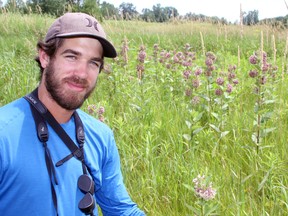Monarch sightings far from 'free'

Article content
Monarch sightings were in fact far from ‘free’ during the 2013 Long Point Butterfly Count.
“Only four monarchs is an all-time low,” reported compiler Adam Timpf Saturday evening, of unofficial results due to the fact he still had to collect data from one of eight participating groups. Average for the monarch is 51 over the past 22 years. “Our previous low was five in 2002, and last year we had a record high of 186.”
The annual butterfly count is similar to a Christmas Bird Count, in that volunteers identify and record species in a 15-mile diametre during a 24-hour period, gathering to share their information at a post-count celebration. Last year, there were 19 butterfly counts in Ontario and 438 in the United States. Data provided at individual counts is ultimately compiled by the North American Butterfly Association.
Individual count data can be useful in terms of local information, says Timpf.
“But it is the most useful when you put in data from all the other butterfly counts from across North America or even Ontario.”
Butterflies can be great indicators of habitat, for example, there are meadow, marsh and forest-specific breeds. Numbers respond to factors including higher corn and soybean prices, for example, in the sense that leads to more agricultural fields. Alternatively, programs like ALUS may favour some breeds over others based on the flora they encourage.
“Meadows are always sort of the thing that disappears,” said Timpf.
Some species require specific host plants, he added.
“And some may nectar out of a variety of plants, but they only lay their eggs on a couple.”
When long-term data is compared, trends can also indicate climatic change.
“That’s when you get the climate thing,” said Timpf. “When you compare all the counts across a broader area.”
Saturday marked the 22nd annual LPBC, and says Timpf, involved roughly 15 volunteers in eight groups.
Lower monarch numbers were anticipated based on a survey from their wintering grounds in Mexico. They suffered due to an extended drought in the U.S. Midwest, reducing available flowers and the nectar butterflies feed on, coinciding with migration attempts.
“It’s like trying to drove somewhere without any gas stations,” said Timpf.
There is also the fact, compared to last year’s early spring and summer, both seasons have been well behind in 2013, alternatively encouraging and discouraging production.
Based on weather alone, Timpf expected last year to this year to resemble the Yin and Yang of butterfly counts, a suspicion the numbers at least partially bore out.
Last year, 4,155 individuals were recorded in 54 species.
“Today, it will be much less,” predicted Timpf, who had personally recorded but a single monarch as of 2 p.m. “It’s underwhelming,” he added with a wry smile. “you have to work for each butterfly.”
With seven of eight groups reporting Saturday, a total of 48 species had been recorded, which is about average, although overall numbers were generally scarce with the notable exception of Edward’s Hairstreak – a species one might surmise thrives in cooler, damper weather. One group reported over 1,000 individuals, well above the previous high of 73, and a number of years without recording a single Edward’s Hairstreak.
“Obviously conditions were perfect for at least one species,” Timpf remarked.
Weather, and the fact breeding cycles may be bisected by a count date are variables in any butterfly count.
“They could be between generations.”
With all factors taken into account, the lack of monarchs in the LPBC is not ideal, but may yet be mitigated by better conditions later in the summer.
“The occasional bad year isn’t the big fear, it’s when you see a long-term trend it gets worrisome. When you see long-term declines, or when species disappear from a count, that’s a warning.”